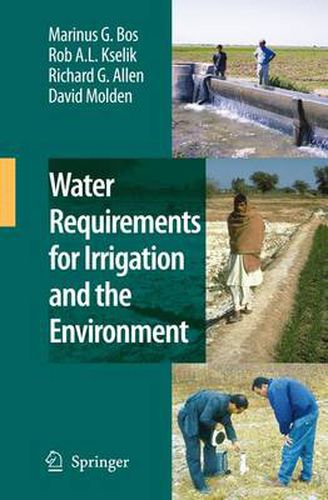Readings Newsletter
Become a Readings Member to make your shopping experience even easier.
Sign in or sign up for free!
You’re not far away from qualifying for FREE standard shipping within Australia
You’ve qualified for FREE standard shipping within Australia
The cart is loading…






This title is printed to order. This book may have been self-published. If so, we cannot guarantee the quality of the content. In the main most books will have gone through the editing process however some may not. We therefore suggest that you be aware of this before ordering this book. If in doubt check either the author or publisher’s details as we are unable to accept any returns unless they are faulty. Please contact us if you have any questions.
Irrigated agriculture produces about 40% of all food and fibre on about 16% of all cropped land. As such, irrigated agriculture is a productive user of resources; both in terms of yield per cropped area and in yield per volume of water consumed. Many irrigation projects, however, use (divert or withdraw) much more water than consumed by the crop. The non-consumed fraction of the water may cause a variety of undesirable effects ranging from water-logging and salinity within the irrigated area to downstram water pollution.
This book discusses all components of the water balance of an irrigated area; evapotranspiration (Ch.2), effective precipitation (Ch.3) and capillary rise from the groundwater table (Ch.4). Chapter 5 then combines all components into a water management strategy that balances actual evapotranspiration (and thus crop yield) with the groundwater balance of the irrigated area (for a substainable environment). Chapter 6 presents CRIWAR 3.0, a simulation program that combines all water balance components into a single simulation procedure. The chapter describes the use of the CRIWAR software for developing water requirement tables and other useful information based on the selected water management strategy. This version greatly expands upon the capabilities of previously published programs.
$9.00 standard shipping within Australia
FREE standard shipping within Australia for orders over $100.00
Express & International shipping calculated at checkout
This title is printed to order. This book may have been self-published. If so, we cannot guarantee the quality of the content. In the main most books will have gone through the editing process however some may not. We therefore suggest that you be aware of this before ordering this book. If in doubt check either the author or publisher’s details as we are unable to accept any returns unless they are faulty. Please contact us if you have any questions.
Irrigated agriculture produces about 40% of all food and fibre on about 16% of all cropped land. As such, irrigated agriculture is a productive user of resources; both in terms of yield per cropped area and in yield per volume of water consumed. Many irrigation projects, however, use (divert or withdraw) much more water than consumed by the crop. The non-consumed fraction of the water may cause a variety of undesirable effects ranging from water-logging and salinity within the irrigated area to downstram water pollution.
This book discusses all components of the water balance of an irrigated area; evapotranspiration (Ch.2), effective precipitation (Ch.3) and capillary rise from the groundwater table (Ch.4). Chapter 5 then combines all components into a water management strategy that balances actual evapotranspiration (and thus crop yield) with the groundwater balance of the irrigated area (for a substainable environment). Chapter 6 presents CRIWAR 3.0, a simulation program that combines all water balance components into a single simulation procedure. The chapter describes the use of the CRIWAR software for developing water requirement tables and other useful information based on the selected water management strategy. This version greatly expands upon the capabilities of previously published programs.